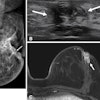CHICAGO - A new technique may allow use of MRI to measure intracranial pressure (ICP) noninvasively, based on data presented on Sunday at the RSNA conference by Noam Alperin, PhD, associate research director for the MRI center at the University of Illinois at Chicago Hospitals.
Current techniques for monitoring ICP are invasive. The most common technique involves insertion of a catheter through the brain parenchyma into the ventricles. Therefore, development of a non-invasive technique to measure ICP could reduce risk and morbidity to patients and would have clinical applications, such as monitoring blunt head trauma, or liver disease that affects ICP.
The new MRI-based technique utilizes information from changes in intracranial volume (ICV) and pressure that occur naturally during the cardiac cycle. With each heart beat, intracranial blood volume rises, causing a corresponding increase in intracranial pressure. The ratio of ICP change and ICV change is used to estimate absolute ICP.
ICV change is calculated from the net transcranial cerebrospinal fluid (CSF) and blood volumetric flow rates. Repeated measurements on healthy volunteers showed that these measurements were reproducible, with an average standard deviation for peak ICV change of 14%.
Pressure changes are determined from the CSF pressure gradient changes. The CSF pressure gradient can be obtained from the CSF velocities using the Navier-Stokes equation and also can be measured reliably, Alperin reported.
In six patients with intracranial catheters, there was good correlation (R-squared=0.965) between invasive and non-invasive ICP measurements over a wide range of ICP values. MRI-based ICP did not yield any false positives when used in 25 healthy volunteers. In addition, in three patients with chronically elevated ICP, there were no false negatives.
Although MRI-based ICP measurement appears promising, it has not yet been evaluated in a clinical setting. Alperin and his colleagues plan to validate the technique by conducting a clinical trial in a trauma center.
By Deborah BarnesAuntMinnie.com contributing writer
November 29, 1999



.fFmgij6Hin.png?auto=compress%2Cformat&fit=crop&h=100&q=70&w=100)















